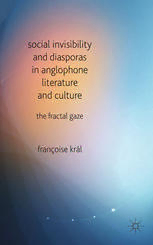Table Of ContentSocial Invisibility and Diasporas in Anglophone
Literature and Culture
Also by Françoise Král
CRITICAL IDENTITIES IN CONTEMPORARY ANGLOPHONE DIASPORIC
LITERATURE
ARCHITECTURE AND PHILOSOPHY: New Perspectives on the Work of
Arakawa and Madeline Gins (co-editor with Jean-Jacques Lecercle)
RE-PRESENTING OTHERNESS: Mapping the Colonial ‘Self’/Mapping the
Indigenous ‘Other’ in the Literatures of Australia and New Zealand (editor)
Social Invisibility and
Diasporas in Anglophone
Literature and Culture
The Fractal Gaze
Françoise Král
Professor, Université de Caen Basse-Normandie, France
© Françoise Král 2014
Softcover reprint of the hardcover 1st edition 2014 978-1-137-40138-0
All rights reserved. No reproduction, copy or transmission of this
publication may be made without written permission.
No portion of this publication may be reproduced, copied or transmitted
save with written permission or in accordance with the provisions of the
Copyright, Designs and Patents Act 1988, or under the terms of any licence
permitting limited copying issued by the Copyright Licensing Agency,
Saffron House, 6–10 Kirby Street, London EC1N 8TS.
Any person who does any unauthorized act in relation to this publication
may be liable to criminal prosecution and civil claims for damages.
The author has asserted her right to be identified as the author of this
work in accordance with the Copyright, Designs and Patents Act 1988.
First published 2014 by
PALGRAVE MACMILLAN
Palgrave Macmillan in the UK is an imprint of Macmillan Publishers Limited,
registered in England, company number 785998, of Houndmills, Basingstoke,
Hampshire RG21 6XS.
Palgrave Macmillan in the US is a division of St Martin’s Press LLC,
175 Fifth Avenue, New York, NY 10010.
Palgrave Macmillan is the global academic imprint of the above companies
and has companies and representatives throughout the world.
Palgrave® and Macmillan® are registered trademarks in the United States,
the United Kingdom, Europe and other countries.
ISBN 978-1-349-48638-0 ISBN 978-1-137-40139-7 (eBook)
DOI 10.1057/9781137401397
This book is printed on paper suitable for recycling and made from fully
managed and sustained forest sources. Logging, pulping and manufacturing
processes are expected to conform to the environmental regulations of the
country of origin.
A catalogue record for this book is available from the British Library.
Library of Congress Cataloging-in-Publication Data
Král, Françoise, author.
Social invisibility and diasporas in Anglophone literature and culture: the fractal
gaze / Françoise Král, Professor, Université de Caen Basse–Normandie, France.
pages cm
Includes bibliographical references and index.
1. Commonwealth l iterature (English)—History and criticism. 2. Social
classes in l iterature. 3. Postcolonialism in literature. 4. Cultural fusion in
l iterature. 5. Women and literature—Commonwealth countries. I. Title.
PR9080.5.K73 2014
820.9'9171241—dc23 2014022747
Typeset by MPS Limited, Chennai, India.
For Geneviève Král
This page intentionally left blank
Contents
List of Illustrations ix
Acknowledgements x
Introduction 1
0.1 Paradigm shifts in diasporas and visibility 6
0.2 Archiving memory and invisible lives 8
Part I Theorizing Invisibility Studies 17
1 Mapping the Invisible: Critical Perspectives on Invisibility 19
1.1 Economic invisibility and the ‘informal sector’ 23
1.2 Political invisibility 28
1.3 Invisibility studies: a methodological predicament 31
Conclusion 41
2 Space, Discourse and Visibility: Towards a Phenomenology
of Invisibility 42
2.1 Space and the location of social invisibility 45
2.2 From place to social space: the invisibility of
the social being 50
2.3 Towards an ethics of invisible lives 63
Conclusion 66
Part II Artistic Scenes of Visibility 67
3 Visibility, Representation and Agency in the Visual Arts:
the Body in Question 69
3.1 Dysgazing: a critique of Western scopophilia 75
3.2 Consensual exposure: towards an ethics of the
visible body 89
Conclusion 99
4 Films and Mass Visibility 101
4.1 Cinematic overexposure and the ‘burden of
hypervisibility’ 104
4.2 Local concerns, global media, dual audiences 119
vii
viii Contents
Part III Sites of Invisibility 131
5 Nation Building and Home Thinking 133
5.1 Performative homes: postcolonial legacies and
the temporality of the home 137
5.2 Shifting lines, moving outlines: home and
the allegory of the nation 143
5.3 Homes in question: towards a symptomatology
of the home in ‘migrant times’ 146
6 Invisibility and the Fractal City 153
6.1 Towards a ‘kineography’ of the city: intersecting
cultural productions and theories of urban planning 156
6.2 Apprehending the fractal city 164
6.3 The ‘fractal gaze’ 169
6.4 Re-segmenting the diasporic subject 172
Conclusion: Unearthing the ‘fractus’: a critique of
cosmopolitanism 175
Concluding Remarks: Fractal Visibility 178
Notes 187
Bibliography 208
Index 227
List of Illustrations
3.1 Larry Rivers, I Like Olympia in Black Face, 1970.
© ADGP © Collection Centre Pompidou, Dist.,
RMN-Grand Palais/Philippe Migeat. 76
3.2 Indoor Gossip. © John F. Lewis. Image courtesy of the
Art Renewal Center®, www.artrenewal.org. 77
3.3 ‘Untitled’, Haddon Photographic Collection,
Cambridge University Museum of Anthropology
and Ethnography, 1995. © Dave Lewis.
Courtesy of the artist. 81
3.4 Still from The Fictions of Science, 1996.
© Keith Piper. Courtesy of the artist. 83
3.5 Recollection, 1995. © Mona Hatoum. Hair balls,
strands of hair hung from ceiling, wooden loom
with woven hair, table. Dimensions variable.
Photo: Fotostudio Eshof. Courtesy of Beguinage
St. Elisabeth, Kortrijk, Belgium, and White Cube. 97
5.1 Home. 1999. © Mona Hatoum. Wood, stainless steel,
electric wire, computerized dinner device, amplifier
and two speakers. Dimensions variable.
Photo: Jörg von Bruchhausen. Courtesy Galerie Max
Hetzler and White Cube. 136
ix

